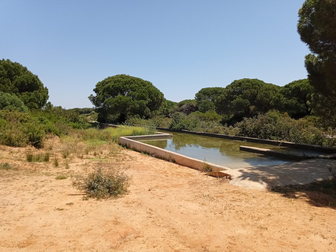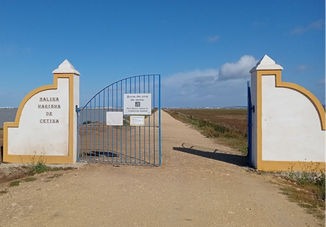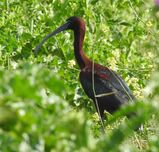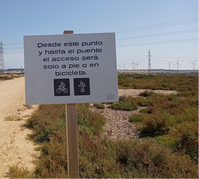 The feeder tank by the road at the NE end of the Dhesa de las Yeguas
The feeder tank by the road at the NE end of the Dhesa de las Yeguas  The open gate has a smaller one inserted for pedestrian access.
The open gate has a smaller one inserted for pedestrian access. 
 Spectacled Warbler habitat behind & to the right of the sign
Spectacled Warbler habitat behind & to the right of the sign | Birding Cadiz Province |
|
|
The vast intertidal mudflats, marshes and salinas of the Bahía de Cádiz may be good habitat for numerous waders, gulls, terns, etc but for the birdwatcher getting into the habitat to obtaining satisfactory views of the birds (even with a 'scope) can be problematical. Large obvious birds like Flamingo aren't a challenge and even Slender-billed Gulls can be picked out at long range with experience but most of the smaller waders are often be too distant for confident identification and some small birds found in the saltmarsh simply impossible to see. However, as the Laguna de Medina - a popular stop for birders - is relatively close-by, a decade or so I go I investigated the area along the CA 3113 with a view to finding a location for gulls, shorebirds and particularly Lesser Short-toed Lark and Spectacled Warbler rather closer than the Bonanza area (c50 minutes from the laguna). A bonus, in some ways a dubious one, was finding that the large rubbish tip (a) was a magnet for Black Kites and even on one occasion, attracted an Eagle Owl. I quickly found all of my targets could be seen along the track into Salinas Santa Maria (b). However, this site wasn't 100% reliable for these species, had few(distant) waders and regular passing heavy lorries (which pick up a veritable dust storm when the track is dry) could make viewing less than ideal. Having checked for tracks into the marismas via GoogleEarth, my next stop was the Pinar de la Dhesa de las Yeguas (c) about 25 minutes drive from the Laguna de Medina. Whilst the woods looked attractive and had plenty of places to park, the track into the marsh was in an appalling state. So I earmarked as somewhere to visit at a later date when it wasn't so hot (it was mid-afternoon in August on that first visit) or when the track was in a better state. Unfortunately, a change in my personal circumstances delayed my next visit until spring 2019 when I found the track in a good condition and that the area was now a reserve but gated and access limited to those with a permit. This was hugely frustrating as I could see that this was a site with great potential. Nonetheless I was keen to revisit this site when Covid restrictions were lifted and somehow, despite my poor Spanish, obtain a permit. I even tried, unsuccessfully, to persuade the authorities to provide an email address by which a permit could be obtained rather than by phone (which required excellent command of Spanish). So when a local correspondent, keen young birder Bruno Asencio Sevilano, informed me that access was now free to pedestrians without a permit, visiting this site in April/May 2022 became my priority. I wasn't disappointed! I've looked at the Pinar de la Dhesa de las Yeguas (c), an attractive open pine woodland with picnic tables and plenty of parking, several times in the past and had already concluded that it was likely that this area of relatively isolated woodland might hold good numbers of migrants in spring. This seems to have been confirmed by the large numbers of Spotted Flycatchers (plus a sprinkling of Pied) I found here. It also has the added attraction of holding both Great-spotted and Iberian Green Woodpecker (a species that has greatly increased in the province). It also has numerous Serin and, given their current scarcity in SE England, I was delighted to find Greenfinch particularly numerous here. Despite the disturbance the site suffers at at weekends, an evening visit in summer should produce Red-necked Nightjar (5+ seen in one evening visit recently).  The feeder tank by the road at the NE end of the Dhesa de las Yeguas The feeder tank by the road at the NE end of the Dhesa de las Yeguas An additional bonus here for those with sharp eyes and, more particularly good hearing, is Savi's Warbler. This species is very sparsely distributed in Spain although the lower Guadalquivir (i.e. Brazo del Este and the Coto Donana) seems to be a hotspot for them. According to the most recent Spanish atlas, they're now absent in this the only regular site I know for them in Cadiz Province. However, up to three reeling birds were found in 2019 and at least one bird was present (although hard to see) in 2022. The best approach is to get there as early as possible, take the track to the right which runs parallel to the CA 3113 and walk along the path (d) following margins of the dry reedbed (optimistically called Laguna de Cetina on some maps). The edge of the wood is also good for migrants whilst Black Kites and Marsh Harriers are usually obvious above the marsh. Multiple paths here take you into the woods and back to the main track but don't neglect the small agricultural aqueduct and feeder tank just beyond the car park by the road as this attracts birds coming down to drink. If you've not got a permit then there's space for several cars to pull off near the gate (e) although in hot weather you might prefer to return to a cooler car and pull off in the shade of the nearest trees. The trade off is that you then have to walk the last c750m. In this context, note that this site is very exposed to the sun with no shade (other than the two hides) so take some water and wear appropriate clothing if you intend to explore the site.  The open gate has a smaller one inserted for pedestrian access. The open gate has a smaller one inserted for pedestrian access. On reaching the gates take care as you enter the reserve since the corner of the large evaporation pool on your left often has a muddy margin attractive to waders (in early May I had Dunlin, Sanderling, Curlew Sandpiper and Little Stint all in a single field of view here). Hopefully, with a little fieldcraft you should be able to enter and obtain good views of any birds. Raising your binoculars a tad and scanning further over the area Flamingos should be immediately apparent with smaller dots quickly resolving themselves to be Black-winged Stilt and Avocets. Taking a closer look at the gulls (preferably with a 'scope) should quickly reveal some Slender-billed Gulls. On my visits this spring I also had a Little Gull here so it's worth spending some time checking through the 'larids'. To your right (f) there's an extensive area of mud supporting a light growth of low halophytic plants. Both here and across the site this habitat is home to Lesser Short-toed Lark; in my experience this is by far the easiest site to catch up with this species in the province. (Greater) Short-toed Lark can also be found here albeit in much lower numbers (and only in summer). Also present in this habitat are Iberian Yellow Wagtail, Kentish Plover and Collared Pratincole (although the latter are more likely to be seen, or heard, long before you spot their mud-coloured forms half-concealed in the vegetation. About 550m from the gate there’s an open-backed hide (g) that provides useful respite from the sun and shelter from the rain. It’s functionality as a hide is somewhat compromised as it faces back towards the way you’ve come so you’re liable to flush birds as you approach but it’s a handy place to stop to scan the salinas for anything you may have missed. There's a good chance of spotting an Osprey (or two) here whilst careful scrutiny of the birds across the vast open water could well throw up Spoonbill (and perhaps Great-white Egret which is increasingly frequent in the province). A further c750m along the track takes you to a second hide (h) which also faces back down the track from which you can again scan over the salinas. On my visit this spring, the small pools along the right-hand side of the track between (g) and (h) seemed particularly productive for small waders so scan these before you head towards the second hide.  If, instead of heading towards the next hide, you take the track to the right after c170m you pass a small pool to the right (i) which can hold more waders plus Glossy Ibis, Purple Swamphen and Purple Heron (although you've got a good chance of seeing all three before you reach this spot). Continuing along this path there are various small pools to the left and right (j) which can harbour still more waders. The latter may include breeding Lapwing which is a relatively scarce bird in the province . As always, as you proceed check for passing raptors (Marsh & Montagu’s Harriers, Booted Eagle, Black Kite, etc) and distant Griffon Vultures but be prepared for surprises, an imm. Bonelli's Eagle was seen here on the day I visited in late April.  Spectacled Warbler habitat behind & to the right of the sign Spectacled Warbler habitat behind & to the right of the sign About 1.5 km along this track from the hide you reach an area of thicker, taller vegetation bordered by a small ditch. The map on the sign at the start of the reserve suggest this is the end of the footpath but another sign here suggests you can walk further (although this is doubtfully worthwhile as ornithologically dull commercial salinas start here). Don't ignore the taller vegetation beyond and to the right of the sign as this is the haunt of Spectacled Warbler, the last of the special passerines to be found here. This diminutive version of Common Whitethroat is an attractive species well-worth the 3 km round trip from the hide. You may need some patience to spot one since unless they're singing and/or song flighting they can be hard to spot in the dense vegetation. The excellence of this site is reflected in the growing number of e-Bird reports (528 at the time of writing, sixty more than in March) and the number of species recorded here (currently 198) - see https://ebird.org/hotspot/L6443288 - which compares favourably with the well-established Salinas de Bonanza which has fewer than twenty more species recorded despite not far short of twice as many trip reports over a much longer time span. Including the nearby woodland, it probably also has a better variety of species close at hand. With access to the better parts of the Salinas de Bonanza now restricted, the Marisma de Cetina is now, arguably, the better site to pick up waders and other specialities of salinas. In the brief period that access has been permitted it's racked up a good list of rarities which in spring 2022 alone included Western Reef Heron & White-winged Black Tern. As suggested earlier, a visit combining a look at this site with one to Laguna de Medina would make for some very productive birding.
1 Comment
David Crawford
7/6/2023 02:15:45 am
Semi-retired academic enjoying time in Medina Sidonia, much impressed by flamingoes, stilts, plovers and ibis at Laguna de Medina. Found this article interesting and informative ... thanks!
Reply
Leave a Reply. |
About me ...Hi I'm John Cantelo. I've been birding seriously since the 1960s when I met up with some like minded folks (all of us are still birding!) at Taunton's School in Southampton. I have lived in Kent , where I taught History and Sociology, since the late 1970s. In that time I've served on the committees of both my local RSPB group and the county ornithological society (KOS). I have also worked as a part-time field teacher for the RSPB at Dungeness. Having retired I now spend as much time as possible in Alcala de los Gazules in SW Spain. When I'm not birding I edit books for the Crossbill Guides series. CategoriesArchives
May 2023
|